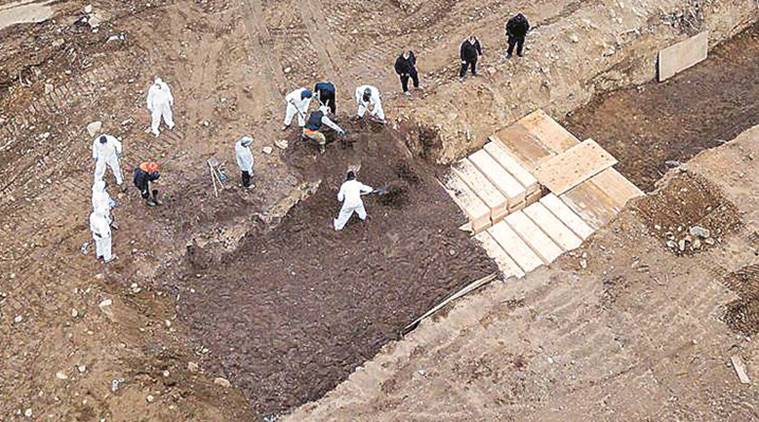 Caption: Bodies being buried in New York’s Hart Island. (Reuters/File)
Caption: Bodies being buried in New York’s Hart Island. (Reuters/File)
Be it a graveyard in central Indore, a funeral home in the midwestern US state of Wisconsin or a cemetery in Italy’s northeastern region of Friuli-Venezia-Giulia; the final journeys are getting lonelier and the last goodbyes shorter. At these three COVID-19 hot spots, continents apart, fear is getting the better of grief and even death doesn’t provide an escape from social distancing.
Indore’s Hafiz Javed, a cemetery caretaker, says the most discomforting moment for him these days is to watch the coffin pushed, rather than lowered, into the grave. “Everyone stands some distance apart from each other. At times, there aren’t enough people to lift the body, so it is difficult to lower them softly. We have to slide them into the pit,” Hafiz says.
With few relatives attending burials, the last rites finish quickly. “We instruct family members to pile mud over the body, and once that is done, we rush to finish the job. No one hangs around, there is not much crying,” Hafiz says.
At the Malwa mill region’s crematorium, too, the pandemic’s shadow looms large. Cloth pouches and steel boxes with ashes hang from hooks or sit on the floor. The lockdown means life — and death — are at a standstill.
Family members of the deceased aren’t turning up to collect the mortal remains. “Some are waiting for things to open so they can travel for ashes immersion; others are paranoid about infection,” says Gauri Kailashpati, a social activist from Indore.
In the US, meanwhile, funerals follow a strict protocol. Wisconsin funeral director John Wenig shares how his son was left speechless by a lady who had lost her husband after 60 years of marriage to COVID-19. “She told my son, ‘Are you telling me I can’t even have a proper funeral for my husband?’ My son said he couldn’t even hug the lady who had broken down. Rules and precautions, you see.”
Elaborate funerals featuring tributes and sharing of memories are a thing of the past.
A US government advisory directs for COVID-19 deceased to be covered in two body bags, and for the face to be covered with a mask. “No one really knows if the virus is active and harmful after death; so, these are precautions.”
There is also a cap on the number of mourners. A maximum of 10 relatives are allowed in the cemetery. Technology has helped. “We started live-streaming the final rites. I remember the first time we had 38 people, second time it jumped to 167 friends and relatives watching it.”
In Friuli-Venezia-Giulia, in north east Italy, Cladio Prescherm is thankful that the worst seems to be over in his region. “All cemeteries are closed here. They are open only when a body is buried. No one is coming to cemetery to lay a rose in these times,” Prescherm says.
“Newspapers in Bergamo are filled with death notices, page after page. That tells you the real story of how many people have died.”
Prescherm’s family have been funeral directors for 150 years now. “Scenes of death and grieving are familiar to me but this has been a strange experience. From fear to sorrow, everything has been different… I think we, as a country, remain shocked by this and need to heal as a group… but first, this virus has to be stopped.”